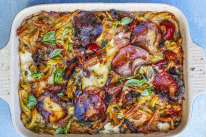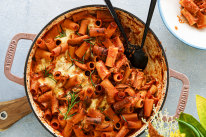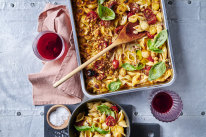Charlotte Ree's comforting lasagne
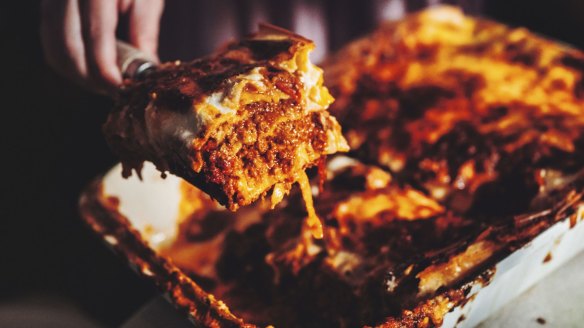
Lasagne-making is ritualistic for me. I find the entire process – from slowly stirring, to rolling out the pasta, to layering – grounding, restorative and meditative. This is a recipe you must prepare ahead. It is time-consuming, but far from difficult. I like to cook the meat sauce for at least six hours but, often, I have it on low and slow for up to 24 hours. From the moment the sauce ingredients are combined, the whole house is filled with its delicious promise.
Ingredients
Pasta dough*
600g tipo 00 flour
6 large eggs, at room temperature
pinch of salt
Bolognese sauce
extra virgin olive oil
1 brown onion, diced
3 large carrots, grated
3 zucchini, grated
3 celery stalks, grated
500g pork mince
500g beef mince
250ml (1 cup) red wine
800g whole peeled tomatoes
140g tomato paste
700g jar tomato passata
250ml (1 cup) full-cream milk
1 tbsp dried oregano
4 garlic cloves, finely chopped
salt and pepper, to taste
Bechamel
4 tbsp cold, unsalted butter
150g plain flour
1.5 litres (6 cups) full-cream milk
1 tsp ground nutmeg
200g parmigiano reggiano, grated, plus extra for topping
mozzarella, grated, for topping
Method
1. Place a heavy-based pot over medium heat, pour in 2 tablespoons of olive oil and gently fry the onion, carrot, zucchini and celery until they soften and reduce, about 20 minutes. Add minced meat and break it into pea-sized pieces with your wooden spoon. Brown slightly, then add the red wine. Season with salt and pepper. Continue to cook the meat until it browns, and the wine reduces, about 10 minutes.
2. Add tomatoes, tomato paste and passata. Stir and cook until mixture bubbles, then turn the heat down to low. Add milk, oregano and garlic as well as some more salt and pepper, if needed. Cover and cook, stirring occasionally, for at least six hours.
3. Make the pasta dough by combining the ingredients in the bowl of a stand mixer fitted with a dough hook. Knead on medium speed for 10 minutes until you have a soft dough that springs back when you gently press your finger into it.
If you do not have a stand mixer, it is time for an arm workout. Pile the flour on a clean, dry work surface and make a well in the middle. Pour in the eggs and, using a fork, gently whisk the eggs. Using the same fork, slowly incorporate the flour into the well, working clockwise, until a clumpy dough forms. Using slightly floured hands, slowly bring the dough together, forming a ball, and knead for 8-10 minutes until you can gently press your finger into it, and it springs back.
In both instances – mixer or handmade – gently flatten the dough ball into a disc and wrap in plastic wrap. Leave it in a cool, dry place for 30 minutes, while you make the bechamel.
4. Preheat the oven to 180C fan-forced (200C conventional) and prepare a baking dish (about 33 x 22 x 7cm or 3-litre capacity) by greasing the bottom and sides with a little olive oil.
5. To make the bechamel, melt the butter in a large saucepan over medium heat. Add the flour and stir constantly with a whisk for about 3 minutes, until the mixture begins to cook and bubble.
Gradually add the milk, stirring constantly to avoid lumps. Slowly bring to the boil, continuing to stir as the sauce thickens, about 8 minutes. You want a beautifully thick, but still slightly runny bechamel, like a gravy, that coats the back of a spoon. Once you have reached that consistency, stir through the nutmeg and grated parmesan and season with salt and pepper.
6. Roll out the lasagne sheets by quartering the rested dough and rolling each sheet either in a pasta machine or with a rolling pin until it is about 1.2mm thick and fits your baking dish. You may need to add a little extra flour to each quarter to stop it sticking (see note).
7. To construct your lasagne, add a ladleful of bolognese sauce to cover the bottom of the baking dish. Top with a layer of pasta, then spread a third of the remaining bolognese sauce over the pasta, then one third of the bechamel and a drizzle of extra virgin olive oil. Repeat with remaining layers, until you reach your final layer of pasta, which you will top with bechamel, a sprinkling of grated parmesan and grated mozzarella.
8. Bake in the oven for 45 minutes, until it is bubbling, golden on top and you are salivating in anticipation! Remove the lasagne from the oven and leave to rest for 10-20 minutes to allow the layers to settle, before cutting into squares or rectangles.
Notes:
I recognise that this recipe is not traditional. It features a sauce that has more liquid than some might like and a bechamel that my nanny taught me how to make by sight. But this is a recipe that is full of my whole heart and one that I have curated, perfected and fussed over for many years.
I love to make the pasta dough with my dinner party guests when they have arrived. It is something we can all do together, and they love to take part. I normally store my rolled sheets on a clothes drying rack, or over the backs of my dining chairs, but if I am making them with friends, I simply roll and add them to my baking dish and layer as I go.
*There is absolutely no need to make your own pasta but I strongly encourage you to. Making your own allows you to craft and cut your pasta sheets to the exact length of your chosen baking dish, rather than cracking and stacking dried pasta sheets to achieve a similar result. If I am using dried, I prefer to use the Barilla egg lasagne sheets, which you can find in all major supermarkets.
You can make the lasagne ahead and leave it to rest until the moment you are ready to bake it. Or you can prepare it in what I like to call "single lady portions" and freeze it to eat whenever you are craving a warm, cheesy cuddle.
Appears in these collections
- Winter layers: Five lush lasagnes to make this weekend
- 14 freezer-friendly dinners to cook-up this week (and stash away for a rainy day)
- That’s amore: Good Food’s ultimate Italian recipe collection
- Five make-ahead share-friendly dishes for weekend meals with mates
- The great Good Food countdown of the 50 most popular recipes of 2022
The best recipes from Australia's leading chefs straight to your inbox.
Sign upFrom our partners
Similar Recipes
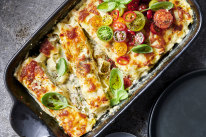
This easy, cheesy chicken cannelloni has a simple summery twist on top
- < 30 mins
- Jessica Brook
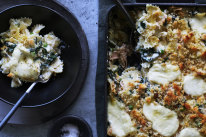
Pasta bake with tuna, silverbeet, stracciatella cheese and peas
- 30 mins - 1 hr
- Karen Martini
